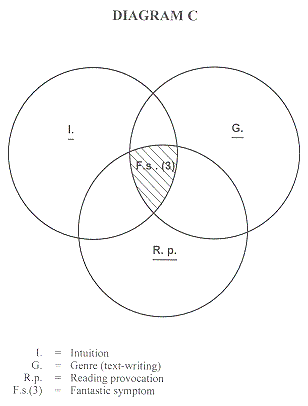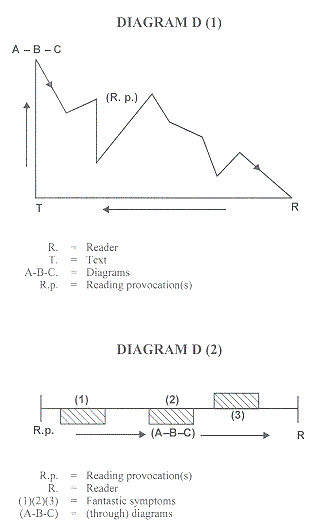Colección: INTERAMER
Número: 55
Año: 1997
Autor: Harry Beleván
Título: The Heirs of Ariadne
VIII
THE FANTASTIC EPISTEME
Reading provocation was the expression
we coined for the set of symptoms of the fantastic that one gets from reading
a text in which those particular signs that we have identified as the properties
of the fantastic are revealed. (By way of illustration, after making one necessary
concession to the notion of genre, we could say that we will know whether there
are fantastic symptoms in, for example, a terror novel if we get a reading
provocation of dereality—in the manner described—that moves us
and makes us feel that we are transcending mere descriptive fear—or form—since,
after all, not all terror novels are fantastic).
Earlier we saw how the fantastic
presents itself to us as an element that triggers alteration, that reveals itself
as a kind of short circuit between the reader and the text; (we might recall
here the reader-text, text-concept and other two-sided encounters). That encounter
between the reader and the text material is a provocation that occurs in the
reading and that causes the reader’s relationship to the text to waver,
hesitate, vacillate. It is the reader-text hinge that demonstrates the
temporal geometry of an absence (M. Brion). The fantastic filters into
reality drop-by-drop and the sensation of suspended time and concrete space
can never be pinned down.
“The very essence of literature...
perceived in its pure state, when one senses the transformation of time in an
imaginary space ... in that mobile absence...,” writes Blanchot apropos
time in the writing of Marcel Proust, concepts of a reality (Proustian time)
that apply equally to the fantastic symptomatic. “In such time [or in such
a symptom, for our purposes]—everything becomes image, and the essence
of the image is to be external, without intimacy, and yet more inaccessible
and more mysterious than the thought of a conscience; with no meaning and yet
appealing to the depths of all possible meaning; unrevealed and yet manifest,
that presence/absence that made the Sirens so alluring and fascinating.”82
Marcel Proust himself proves to us that the fantastic is a symptom—isn’t
his Remembrance of Things Past a “fantastic work”?—when,
for example, he senses that a misstep on the patio of Guermantes is the
false step on the uneven tiles of the Baptistery at San Marcos, not “a
double, not an echo of a previous sensation... but the sensation itself,”
the same split, the “presence-absence” (M. Blanchot) that is inherent
to the fantastic. If, in an example taken at random, the fantastic episteme
can be realized, then how many more possibilities there must be of the presence
of the fantastic in works that, because of their particular textuality, are
more predisposed toward it.

The process, then, can be summarized as follows:
the textual slippage matches a particular “realistic” (realistic writing)
with a “derealistic” (or derealistic description). That textual slippage
triggers what we have called a dialectical opposition from whence comes, via
the dislocation we described earlier, a new order (as text-concept).
That new order or fantastic descripture in turn brings about the reading
provocation whereby the fantastic manifests itself.
The circuit has been closed: without ever
ceasing to be an episteme, as episteme the fantastic has been realized (real-ized)
in full. (We must insist that, as the following diagram demonstrates, the entire
process is one of indivisible simultaneity, a burst of immediacy that contemporizes
all the mechanisms described earlier.)


